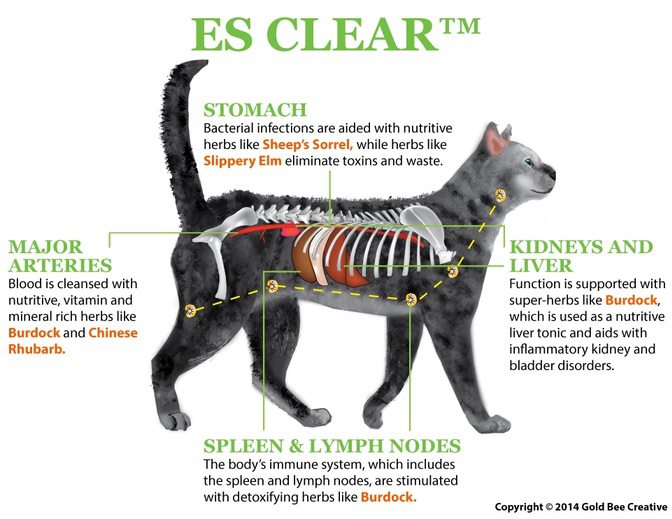cancer support

free shipping over $100 (USA & Canada)
1-877-937-4372 the pet expert hotline


Ear mites usually produce a characteristic, abundant, dry, black ear discharge.
In our practice, ear mites are prevalent in feral and outdoor cats, but uncommon in dogs. Often, clients will call for an appointment for their dog or cat’s ear problem stating it may be a mite infection, when in fact, it is a much more common bacterial or yeast infection. Ear mite infections and bacterial/yeast infections of the ear can show many of the same symptoms such as head shaking, scratching at the ears, and rubbing the face.
Ear mites, or Otodectes cynotis, are tiny mites resembling microscopic ticks. It usually produces a characteristic, abundant, dry, black ear discharge. The mite is detected by examining a sample of ear wax under a microscope with mineral oil. The live mites will be seen clearly, often still alive and moving. Cytologic ear swabs are taken in conjunction to rule out bacterial or yeast infections in the ears causing the same symptoms, with or without mites. When we diagnose mites under the microscope we often have clients come to see them under the microscope as the critters are very active and interesting to observe. It makes sense after seeing how miserable your pet can become.
Ear mites live on the surface of the ear canal skin. Eggs are laid and hatch after 4 days. When the larva hatches from the egg, it feeds on ear wax and skin oils for about a week, then develops and reproduces in the ear. The adult mite lives approximately two months. The life cycle – the time it takes for an egg to develop into an adult mite ready for parenthood – requires three weeks.
Ear mites are highly contagious and are easily spread between cats and less likely dogs. Because it is so contagious, treatment for mites must include all the pets in the household. Typically, the patient is an outdoor cat. Humans are extremely unlikely to experience any symptoms when ear mites infected their pet.
Ear mites cause inflammation and can generate very irritating ear infections. Skin disease can also result from ear mite infection from scratching so hard.
Eradicating ear mites may be multi-modal, depending on what your veterinarian decides is the best treatment for your cat or dog. These treatments include topical and/or oral medications. Prevention includes regular exams with your veterinarian and routine ear cleaning at home. NHV Echo Gold can help to keep the ears clean and reduce inflammation. If the discharge is excessive or the ear is uncomfortable and/or very itchy, your veterinarian needs to take a look at it, as severe infections can cause the eardrum to rupture. Instilling anything into an ear with a ruptured eardrum can be very damaging.
Keeping your pet on a healthy, complete diet as well as immune support can prevent an infection. NHV products such as ES Clear and BK Detox, Pet Omega 3 are very helpful in supporting optimal immune health.
cancer support

Natural cat cancer support
buy 2 and save $3
3 month supply for a small to medium size pet.
Es Clear is a 100% natural herbal pet supplement formulated by veterinarians. Feed your pet ES Clear to help support them through cancer as part of their overall holistic cat cancer treatment plan recommended by your vet.


Es Clear is a 100% natural herbal pet supplement formulated by veterinarians. Feed your pet ES Clear to help support them through cancer as part of their overall holistic cat cancer treatment plan recommended by your vet.

Support your cat’s healing naturally with NHV’s ES-Clear, a well-balanced dietary supplement that is vet-approved to help manage symptoms of feline cancer. ES-Clear contains four highly effective herbs that promote health and are safe to be given long-term in conjunction with conventional treatment.
In addition, ES Clear, natural cat cancer support helps:
The potent blend of herbs found in ES-Clear will target critical areas in the body such as the kidneys, liver, stomach, major arteries as well as the spleen and lymph nodes which make this an excellent supportive cat cancer care.
NHV Natural Pet Products contains pure herbal extracts with no artificial additives, preservatives or coloring. They’re formulated by a master herbalist and holistic veterinarian with over 50 years of combined experience. You can read more about cat cancer treatments that can augment a vet-recommended cancer treatment plan on Dr. Hillary Cook's blog.
Pet parents that found ES-Clear beneficial also found Turmeric for cat cancer symptoms to be helpful. If you are unsure of which products would best help your feline family member, you can schedule a consultation because, at NHV, we want your kitty to pounce back to purrfect health naturally.

Burdock - This vitamin-rich powerful herb supports the liver, helps to clean the blood in major arteries and even has free-radical scavenging properties.
Sheep’s Sorrel - This potent herb contains a healthy source of vitamins and minerals, such as beta-carotene which is high in antioxidants.
Slippery Elm - Another vitamin and mineral-rich herb that also contains anti-inflammatory properties that aid in soothing stomach irritations which can be made worse due to the side effects of some conventional cancer medicines.
Chinese Rhubarb - Due to the powerful astringent properties of this herb, there is an increase in the removal of toxins and an improvement in gallbladder function. Chinese Rhubarb also helps the appetite, which can suffer due to the side effects of many cat cancer treatment medicines.
Select your pet's weight to determine the correct dose.
Support your cat’s healing naturally with NHV’s ES-Clear, a well-balanced dietary supplement that is vet-approved to help manage symptoms of feline cancer. ES-Clear contains four highly effective herbs that promote health and are safe to be given long-term in conjunction with conventional treatment.
In addition, ES Clear, natural cat cancer support helps:
The potent blend of herbs found in ES-Clear will target critical areas in the body such as the kidneys, liver, stomach, major arteries as well as the spleen and lymph nodes which make this an excellent supportive cat cancer care.
NHV Natural Pet Products contains pure herbal extracts with no artificial additives, preservatives or coloring. They’re formulated by a master herbalist and holistic veterinarian with over 50 years of combined experience. You can read more about cat cancer treatments that can augment a vet-recommended cancer treatment plan on Dr. Hillary Cook's blog.
Pet parents that found ES-Clear beneficial also found Turmeric for cat cancer symptoms to be helpful. If you are unsure of which products would best help your feline family member, you can schedule a consultation because, at NHV, we want your kitty to pounce back to purrfect health naturally.

Burdock - This vitamin-rich powerful herb supports the liver, helps to clean the blood in major arteries and even has free-radical scavenging properties.
Sheep’s Sorrel - This potent herb contains a healthy source of vitamins and minerals, such as beta-carotene which is high in antioxidants.
Slippery Elm - Another vitamin and mineral-rich herb that also contains anti-inflammatory properties that aid in soothing stomach irritations which can be made worse due to the side effects of some conventional cancer medicines.
Chinese Rhubarb - Due to the powerful astringent properties of this herb, there is an increase in the removal of toxins and an improvement in gallbladder function. Chinese Rhubarb also helps the appetite, which can suffer due to the side effects of many cat cancer treatment medicines.
Select your pet's weight to determine the correct dose.
immune support

Cat Immune System Booster, Cancer Support, Gentle Detox, and Blood Cleanser
buy 2 and save $3
3 month supply for a small to medium size pet.
All natural, gentle, herbal support for cats, dealing with compromised immune systems that helps detoxify the vital organs and blood.


All natural, gentle, herbal support for cats, dealing with compromised immune systems that helps detoxify the vital organs and blood.

Cats live in a world full of pollutants that they breathe, ingest, and play in every day. BK Detox is a gentle herbal detox that helps Protect them with BK Detox, an all-natural cat immune system booster and detoxifier specially formulated to restore balance, regulate the immune system, and help your pet live a healthier, happier life.
BK Detox is especially useful for pets suffering from:
BK Detox will help your cat to gently flush out toxins from their vital organs and cleanse the blood. This is a cat immune supplement that promotes their long-term vitality.
The immune system plays an important role in helping your cat resist infection and overcome sickness.
When the immune system is compromised, toxins can accumulate in your cat and cause problems including liver disorders, urinary tract infections, skin allergies, tumors, bad breath, and respiratory issues.
“Boost” is a common term used for supplements that make the immune system work better, but supplements like NHV more accurately help to balance the immune system. The goal of cat immune system boosters like BK Detox is to balance the immune system so that it can more effectively respond to threats and process toxins out of their body.
BK Detox was formulated by a holistic veterinarian completely from 100% natural ingredients. It is safe for your cat to take alongside any conventional medicine prescribed by their veterinarian, including long-term medications.
See how BK Detox helped Holly with her allergies
How do you know if BK Detox will help your cat? Call our pet expert hotline at 1-877-937-4372 with questions about boosting your cat’s immune system. You can also visit our Pet Expert Q&A.

Red Clover – A blood-purifying herb with antibiotic and anti-inflammatory properties. It promotes cleansing and the elimination of toxins and deposits through diuretic and expectorant activity.
Cleavers – A tonic that increases the circulation of lymph-impaired areas of the body and aids in the drainage of lymph-engorged cysts, tumors, and inflamed tissues of the urinary tract.
Neem – An evergreen tree with powerful blood purifying and detoxifying effects.
Oregon Grape – Supports and improves digestion by helping rid the body of waste and toxins in the blood.
Gotu Kola – A small green herb known for its cleansing, diuretic, and strong antioxidant properties.
Buckthorn – A gentle laxative and blood-cleansing tonic.
Burdock – A highly effective blood purifier abundant in calcium, phosphorus, iron, thiamine, and riboflavin. Supports the entire body while gently eliminating toxic build up.
Sarsaparilla – A cleansing herb that stimulates the kidneys to flush deposits and clear toxins.
Echinacea Angustifolia – Cat immune system booster. Stimulates the body’s defense mechanism.
Chaparral – A blood purifying antioxidant rich in amino acids.
Prickly Ash – A tonic that stimulates the entire lymphatic system to encourage the elimination of toxic metabolites.
Select your pet's weight to determine the correct dose.
Bk Detox can be used as a detoxifier every 6 months. For best results administer the recommended dosage until the bottle is finished.
To be taken twice daily. Determine your pet’s weight and then use the easy chart below to determine the correct dose. This is the minimum dosage.
Pet's Weight Dosage
0 - 15 lb = 0.5 ml
16 - 30 lb = 1.0 ml
31 - 45 lb = 1.5 ml
46 - 60 lb = 2.0 ml
61 - 75 lb = 2.5 ml
Over 75 lb = 3.0 ml
How to Administer: Shake well before use. The easiest method is to use the dropper provided and place the drops into your pet’s food or favorite treat. You can also use the dropper and squirt directly into the pet’s mouth. Some pets can be finicky, if this occurs consider hiding the drops in foods most pet’s love such as fish, chicken, yogurt, or a favorite treat. If your pet only eats dry food then soak a few kibbles at feeding time.
For Best Results
Herbal dietary supplements are beneficial to the health and well-being of your pet and are safe for long-term use. Every pet responds to natural herbal supplements differently, therefore it is important to be consistent and administer the product daily. Supplements generally take two to four weeks to take effect, however this will vary from one animal to the next.
Product Storage
All NHV Natural Pet Products are pure herbal extracts and contain no artificial additives, preservatives, or coloring. Shelf life after opening is 6 months and must be refrigerated after opening.
Cautions and Contraindications
Do not use BK Detox in pregnant or nursing animals.
Speak to your vet before using our products. A second visit is recommended if your pet’s condition does not improve, or deteriorates after continued use of the supplements.
All information provided by NHV Natural Pet Products is for educational purposes only.
Cats live in a world full of pollutants that they breathe, ingest, and play in every day. BK Detox is a gentle herbal detox that helps Protect them with BK Detox, an all-natural cat immune system booster and detoxifier specially formulated to restore balance, regulate the immune system, and help your pet live a healthier, happier life.
BK Detox is especially useful for pets suffering from:
BK Detox will help your cat to gently flush out toxins from their vital organs and cleanse the blood. This is a cat immune supplement that promotes their long-term vitality.
The immune system plays an important role in helping your cat resist infection and overcome sickness.
When the immune system is compromised, toxins can accumulate in your cat and cause problems including liver disorders, urinary tract infections, skin allergies, tumors, bad breath, and respiratory issues.
“Boost” is a common term used for supplements that make the immune system work better, but supplements like NHV more accurately help to balance the immune system. The goal of cat immune system boosters like BK Detox is to balance the immune system so that it can more effectively respond to threats and process toxins out of their body.
BK Detox was formulated by a holistic veterinarian completely from 100% natural ingredients. It is safe for your cat to take alongside any conventional medicine prescribed by their veterinarian, including long-term medications.
See how BK Detox helped Holly with her allergies
How do you know if BK Detox will help your cat? Call our pet expert hotline at 1-877-937-4372 with questions about boosting your cat’s immune system. You can also visit our Pet Expert Q&A.

Red Clover – A blood-purifying herb with antibiotic and anti-inflammatory properties. It promotes cleansing and the elimination of toxins and deposits through diuretic and expectorant activity.
Cleavers – A tonic that increases the circulation of lymph-impaired areas of the body and aids in the drainage of lymph-engorged cysts, tumors, and inflamed tissues of the urinary tract.
Neem – An evergreen tree with powerful blood purifying and detoxifying effects.
Oregon Grape – Supports and improves digestion by helping rid the body of waste and toxins in the blood.
Gotu Kola – A small green herb known for its cleansing, diuretic, and strong antioxidant properties.
Buckthorn – A gentle laxative and blood-cleansing tonic.
Burdock – A highly effective blood purifier abundant in calcium, phosphorus, iron, thiamine, and riboflavin. Supports the entire body while gently eliminating toxic build up.
Sarsaparilla – A cleansing herb that stimulates the kidneys to flush deposits and clear toxins.
Echinacea Angustifolia – Cat immune system booster. Stimulates the body’s defense mechanism.
Chaparral – A blood purifying antioxidant rich in amino acids.
Prickly Ash – A tonic that stimulates the entire lymphatic system to encourage the elimination of toxic metabolites.
Select your pet's weight to determine the correct dose.
Bk Detox can be used as a detoxifier every 6 months. For best results administer the recommended dosage until the bottle is finished.
To be taken twice daily. Determine your pet’s weight and then use the easy chart below to determine the correct dose. This is the minimum dosage.
Pet's Weight Dosage
0 - 15 lb = 0.5 ml
16 - 30 lb = 1.0 ml
31 - 45 lb = 1.5 ml
46 - 60 lb = 2.0 ml
61 - 75 lb = 2.5 ml
Over 75 lb = 3.0 ml
How to Administer: Shake well before use. The easiest method is to use the dropper provided and place the drops into your pet’s food or favorite treat. You can also use the dropper and squirt directly into the pet’s mouth. Some pets can be finicky, if this occurs consider hiding the drops in foods most pet’s love such as fish, chicken, yogurt, or a favorite treat. If your pet only eats dry food then soak a few kibbles at feeding time.
For Best Results
Herbal dietary supplements are beneficial to the health and well-being of your pet and are safe for long-term use. Every pet responds to natural herbal supplements differently, therefore it is important to be consistent and administer the product daily. Supplements generally take two to four weeks to take effect, however this will vary from one animal to the next.
Product Storage
All NHV Natural Pet Products are pure herbal extracts and contain no artificial additives, preservatives, or coloring. Shelf life after opening is 6 months and must be refrigerated after opening.
Cautions and Contraindications
Do not use BK Detox in pregnant or nursing animals.
Speak to your vet before using our products. A second visit is recommended if your pet’s condition does not improve, or deteriorates after continued use of the supplements.
All information provided by NHV Natural Pet Products is for educational purposes only.
overall vitality

For Overall Health and Well-Being
buy 2 and save $3
An Omega 3 supplement for cats to support their joints, heart, eyes, immune system, and overall organ function.


An Omega 3 supplement for cats to support their joints, heart, eyes, immune system, and overall organ function.

Our cat omega 3 supplement is naturally made from the oils of sardines, anchovies, and North Atlantic cod. It’s an excellent source of EPA (Eicosapentaenoic Acid 600mg) and DHA (Docosahexaenoic acid 460mg) essential omega 3 fatty acids. It’s molecularly distilled and cold-pressed to improve the bioavailability
Support your cat with human-grade quality omega 3 fish oil supplements. Many processed pet foods are deficient in this important nutrient. And according to the University of Maryland Medical Center, "It is very important to maintain a balance between omega-3 and omega-6 fatty acids in the diet. A proper balance helps maintain and even improve health."
It’s important for cats to get essential fatty acids through their diet. This omega 3 supplement for cats will help keep them healthy, and even finicky cats actually like to take it.
Benefits of Cat omega 3 supplements:

Suggested Dosage: To be taken once per day. Add to food based on weight chart.
Therapeutic Dosage: Double the quantity for maximum period of 4 weeks or follow veterinarian advise.
Pet’s Weight Dosage
0-15 lb = ¼ tsp
15-30 lb = ½ tsp
30-60 lb = 1 tsp
60-90 lb = 1 ½ tsp
How to Administer: Shake well before use. The easiest method is to add the dosage to your pets food. Some pets can be finicky, if this occurs consider hiding the appropriate amount in food most pet’s love such as fish, chicken, yogurt, or a favorite treat. If your pet only eats dry food then soak kibbles at feeding time.
For Best Results
Dietary supplements are beneficial to the health and well-being of your pet and are safe for long-term use. Every pet responds to natural supplements differently, therefore it is important to be consistent and administer the product daily. Supplements generally take two to four weeks to take effect, however this will vary from one animal to the next.
Product Storage
All NHV Natural Pet Products contain no artificial additives, preservatives or coloring. Shelf life after opening is 6 months and must be refrigerated after opening.
Cautions and Contraindications
Avoid During Pregnancy.
Our cat omega 3 supplement is naturally made from the oils of sardines, anchovies, and North Atlantic cod. It’s an excellent source of EPA (Eicosapentaenoic Acid 600mg) and DHA (Docosahexaenoic acid 460mg) essential omega 3 fatty acids. It’s molecularly distilled and cold-pressed to improve the bioavailability
Support your cat with human-grade quality omega 3 fish oil supplements. Many processed pet foods are deficient in this important nutrient. And according to the University of Maryland Medical Center, "It is very important to maintain a balance between omega-3 and omega-6 fatty acids in the diet. A proper balance helps maintain and even improve health."
It’s important for cats to get essential fatty acids through their diet. This omega 3 supplement for cats will help keep them healthy, and even finicky cats actually like to take it.
Benefits of Cat omega 3 supplements:

Suggested Dosage: To be taken once per day. Add to food based on weight chart.
Therapeutic Dosage: Double the quantity for maximum period of 4 weeks or follow veterinarian advise.
Pet’s Weight Dosage
0-15 lb = ¼ tsp
15-30 lb = ½ tsp
30-60 lb = 1 tsp
60-90 lb = 1 ½ tsp
How to Administer: Shake well before use. The easiest method is to add the dosage to your pets food. Some pets can be finicky, if this occurs consider hiding the appropriate amount in food most pet’s love such as fish, chicken, yogurt, or a favorite treat. If your pet only eats dry food then soak kibbles at feeding time.
For Best Results
Dietary supplements are beneficial to the health and well-being of your pet and are safe for long-term use. Every pet responds to natural supplements differently, therefore it is important to be consistent and administer the product daily. Supplements generally take two to four weeks to take effect, however this will vary from one animal to the next.
Product Storage
All NHV Natural Pet Products contain no artificial additives, preservatives or coloring. Shelf life after opening is 6 months and must be refrigerated after opening.
Cautions and Contraindications
Avoid During Pregnancy.
Published: November 30, 2018